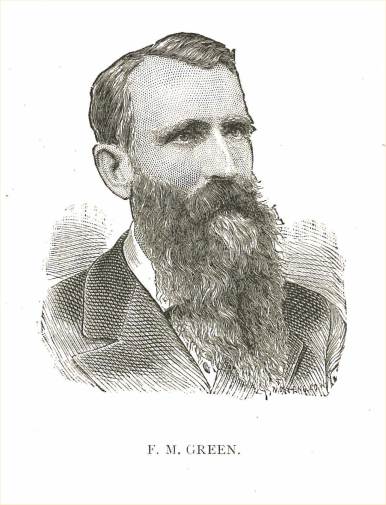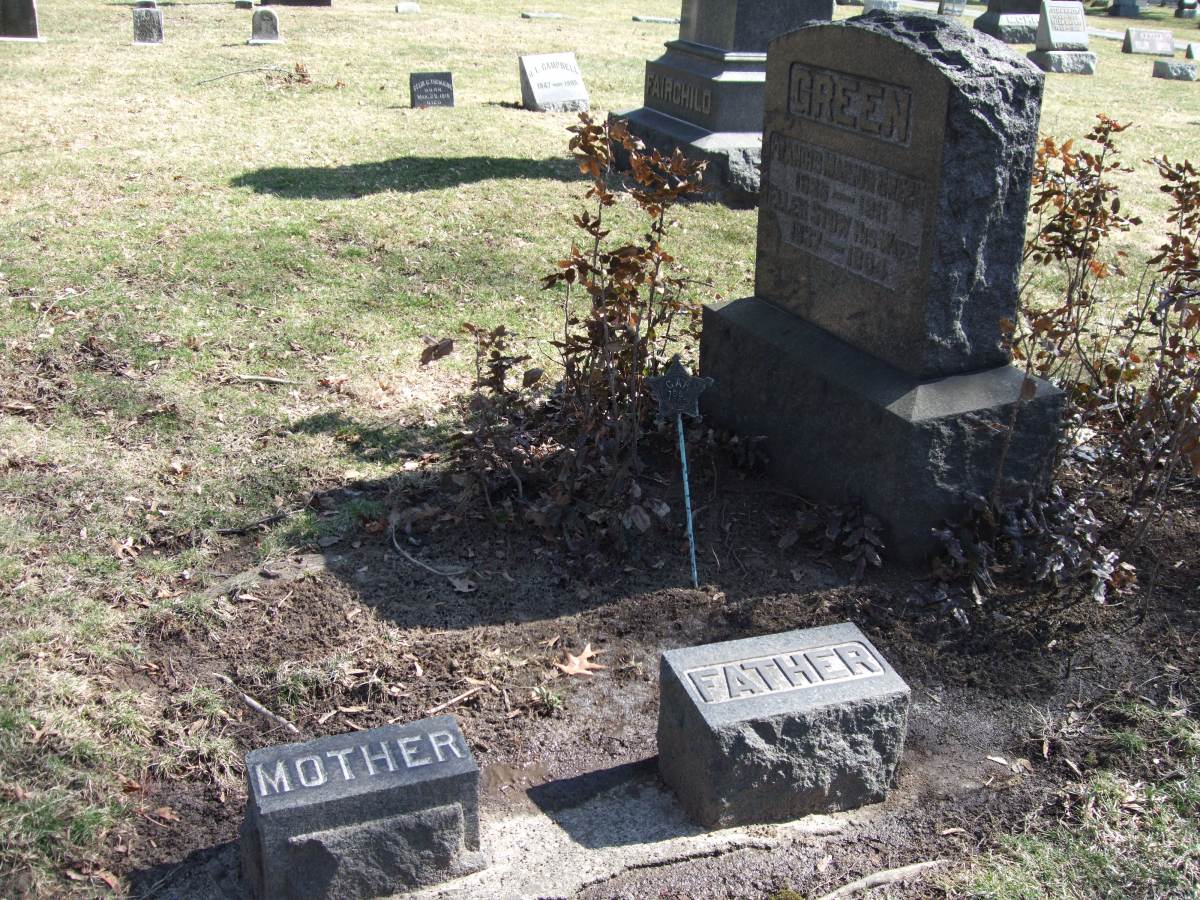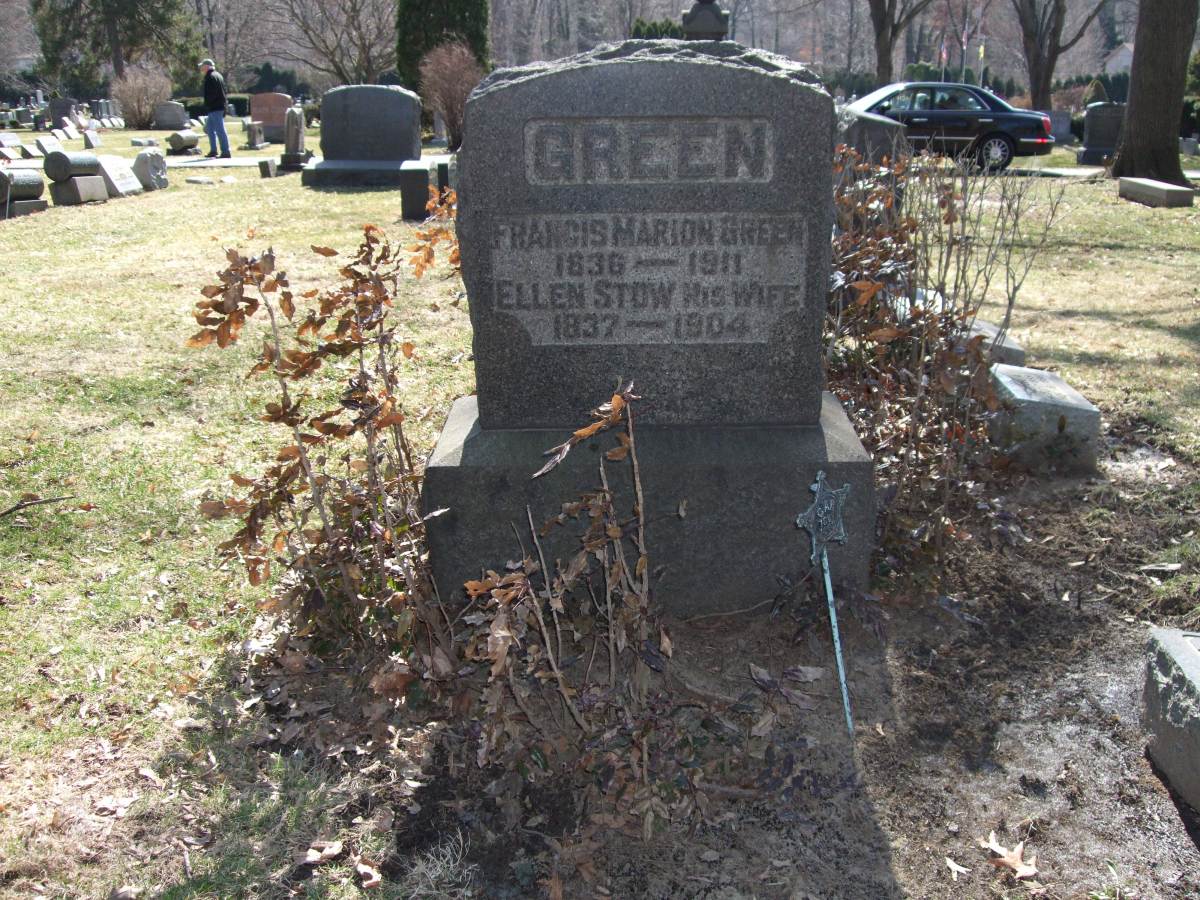Francis Marion Green
1836-1911
![]()
Biographical Sketch on the Life of Francis Marion Green
Francis M. Green was born in Norton Township, Summit County, Ohio, September 28, 1836. During his youth and early manhood he worked on a farm in the summer, and attended or taught school during the remainder of the year. Blessed with Christian parents, he was early trained in the best of all seminaries, the Christian home, and was easily persuaded to the obedience of the gospel. In September, 1852, when sixteen years of age, he made a public profession of faith in Christ, and was baptized by Dr. W. A. Belding. The next year he entered Hiram College, then called the "Western Eclectic Institute." Here he remained as a student for several years, enjoying among his many advantages the personal instruction and friendship of James A. Garfield.
Having chosen the ministry of the gospel as his life-work, he delivered his first sermon, September 13, 1863, at Manchester, O(hio). Since that time he has been constantly and actively engaged in ministerial labors. He has always been a warm friend and earnest helper of Christian missions; and from 1878 to 1882 he served as Corresponding Secretary of the General Christian Missionary Convention, traveling, preaching, and working, in the interest of our home missions.
Bro. Green is most widely known among us as a writer, and especially as a writer for children and on Sunday-school topics. He is the "Uncle Frank" of our Sunday-school papers. He has for years been a regular contributor to the Sunday-school Standard, and associate editor of the Teacher's Mentor. Of the Teacher's Mentor has recently become editor-in-chief. He has been for several years on the editorial staff of the Christian Standard. During this time he has traveled extensively, and the notes of his travels published in the Standard have contained much of interest and information, especially concerning our own people and work in the several States visited by him. Bro. Green is also the author of the following volumes: "The Standard Manual for Sunday-school Workers;" "The Christian Minister's Manual;" "A Royal Life: or, the Eventful History of fames A. Garfield;" and "Christian Missions, and Historical Sketches of Missionary Societies Among the Disciples of Christ."
Bro. Green is at present living on his farm in Stowe, Summit County, Ohio, where he has a delightful home; and he is the pastor of the Church of Christ there. He is in the prime of life and health, and it is to be hoped that he has only, as yet, fairly begun his best work for the Master.
-Disciples Of Christ, 1885, ed. Isaac & Russell Errett, Christian Standard Publishing Co., pages 688-692![]()
ELEMENTS OF CHRISTIAN PROSPERITY
A Sermon By Francis M. Green

"Then had the churches rest throughout all Judea and Galilee and Samaria, and were edified; and walking in the fear of the Lord and in the comfort of the Holy Ghost, were multiplied."Acts ix. 31.
In the Revised Version of the New Testament our text reads as follows: "So the church throughout all Judea and Galilee and Samaria had peace, being edified; and, walking in the fear of the Lord and in the comfort of the Holy Spirit, was. multiplied."
The history of which our text is a part is extremely significant and interesting. 1t is the history of a contest and victory unparalleled in the flaming records of warfare. The early Christians had faced their first persecutions, and remained firm in their faith in the risen Lord, whose power had shaken to its foundations the "City of the Great King."
Stephen was in the grave, into which his murderers had stoned him, and the tiger of persecution, whose fangs had found the heart of Jesus, licked its jaws red with this second taste of blood, and prepared for the extermination of the followers of the Christ. But the fire of-faith was well kindled in the hearts of the disciples, and as Satan trampled upon them he only flung afar the blazing brands for a wider kindling. The disciples were scattered abroad, and "went everywhere preaching the word." It had been a tremendous struggle against great odds, and until now the church had been almost entirely on the defensive; but at the period named in our text it had begun an aggressive warfare. Saul of Tarsus, the leader of the most relentless band of persecutors, was captured, his followers were defeated; and then came peace. The banner of Bethlehem's star was flung to the breeze, never to be furled until the banners of the kingdoms of the world should salute it in the day of final triumph.
The conflict had been good for the disciples. It weeded out the hypocrites and time-servers from the church. It tested the stamina of the true Christians. It gave the centrifugal power which compelled them to talk about their principles and their Redeemer everywhere.
The rest, or peace, which followed the conflict was helpful, also. It strengthened the weak knees. It encouraged despondent souls. It gave opportunity for quiet thought and meditation on the mercies of God. It ennobled the tired fighters to repair damages, reinforce their ranks, discipline their army, and lay a broader basis for future campaigns of victory.
The rest which became their portion after the severe struggles through which they had passed was peace, and not inactivity. They were as active as ever. And in the sense of cessation from labor there can be no rest for the true Christian; this side of the time when he enters the enjoyment of that "rest which remaineth for the people of God."
"The captive's oar may pause upon the galley, The soldier sleep beneath his plumed crest, And peace may fold her wing o'er hill and valley; But thou, O Christian, must not take thy rest."
Two things are worthy of profound attention in the history of these early disciples.
First, they were edified, or built up; and second, they were greatly increased. These are blessed enviable results which every church and every Christian ought to desire. These early disciples walked in the fear of the Lord and heeded the exhortation of the Holy Spirit; and they were edified and multiplied.
Let it be observed, in the first place, that it was an individual improvement that lifted the whole church into a general atmosphere of spiritual life. It is nonsense to speak of a church as anything that its individual members are not. If a church is liberal, it is because its members give liberally of such things as they have. If a church is worldly or corrupt, it is because its members are worldly and corrupt. If a church is zealous and useful, it is because the members are zealous and work for Christ. The stream will rise no higher than its source, and a church will be no better than its members are. The design of Christianity is to make whole men, and not partial, one-sided, deformed men. Christ is preached that every man may be warned and taught, and made perfect in him. No building is fairer than the temple of the human heart and life wherein Christ dwells. No building equals this, which all Christians have before them, of character, moral development, spiritual growth, up-building in holiness by the power of the Great Architect, who first began the work in their souls, resting on Christ, the only sure foundation. Every life without that basis is a house upon the sand, a castle in the air. But so begun, "the life goes up story after story as years wear on, rooms filled with furniture of graces and hung about with pictures of a grateful memory. all insured against the fires of the last day, yet only roofed in, complete in glory, the capstone put on with hallelujahs of the blessed."
There are many fields on which Christians may be active and thereby be built up. In the public ministry of the word; in the private, quiet, fire-side teaching of the holy law; in the Sunday-school; in the blessed ministries of consolation and comfort to the desolate, the needy, and the dying; in the great markets of the world, where men jostle each other in the business of life; in the sacred home-circle, where faith is queen and love is king; 'in the halls of learning, and in the temples of legislation; everywhere, may a suitable field be found for Christian growth and development.
But it is also said of this early church, that it was greatly increased because it walked in the fear of the Lord and in the comfort, or exhortation, of the Holy Spirit. Edification and multiplication, these are the necessary elements in real Christian prosperity. They must go arm in arm to abiding success. Increase without edification is not prosperity, any more than a pile of bricks by the roadside is a building. On the other hand, edification without increase is proof of personal selfishness, willing to take its banquet from God's bounty and leave the multitudes within its reach to starve. How many say, "I am rich, and increased with goods, and have need of nothing." All such see but one side of prosperity; and when their riches and honor pass away, all that is left to say of them is, "Thou art wretched, and miserable, and poor, and blind, and naked." Churches frequently appear to think that if they have a great many" additions" they are having great prosperity; when in fact their numbers may be but weakness. It will always be so unless edification, the building up of the individual character and life, shall go hand in hand with the increase. It is a glorious thing to say of the church that it is at peace. But it is more glorious to be able to say that the church is at peace, and that its members are walking in the fear of God and in the comfort of the Holy Spirit, and so are built up and greatly increased. The history of these early disciples furnishes to us some lessons of great practical value.
1. These disciples walked in the fear of the Lord. They practically illustrated what Christ could do for men, by what he had done for them. In their lives they illustrated the fact that men are capable of holy living, though surrounded by the temptations of sin; and of a righteousness that far exceeded the righteousness of the scribes and the Pharisees. And, whether they knew it or not, they taught that the logic of a man's life is mightier than the speech of any silver-tongued eloquence; for though a man may talk like a seraph, if his life is that of a devil he kills his own arguments faster than he can make them. It is as true now as ever, that the church needs quality as well as quantity in its membership. Because of this lack it has been declared that one half of professed Christians amount to nothing. There is in them no firm grip of the truth, no enthusiastic service for Christ, no cheerful self-denial, no overmastering prayer, no capacity "to strike hard blows for God." Instead of loyalty to God, they walk in the fear of men; and they soon droop and die by the way.
2. These disciples heeded the exhortation of the Holy Spirit. . .This gave them a power which no science could explain, or mere worldly effort parallel. It made brave men of cowards, and mighty men, majestic in their knowledge, of the timid and illiterate. If the Holy Spirit does not pervade it, the church is an agency of no more use in the Master's service than a political caucus or a board of brokers.
It is a fatal error to think that the literal following of the New Testament teaching and practices is not required in these our days. The Lord certainly requires this following or he would not have given the teaching. It is a complete and perfect transcript of the divine mind on all matters on which it treats. Its principles, like its Author, are the same yesterday, today, and forever; and the very worst feature in modern Christian life is the departure from these living oracles of God.
Brethren, as the cross is our theme, our boast, and our inspiration, let it be also our wisdom and our power. Thence must spring our confidence, our consecration, our agony for the rescue of men. With our trust there, we can smile through our tears, be strong in our sorrow, and victorious in our trembling.
It is not only for others, but for ourselves, that the utmost diligence is required. Does your store, your farm, or your shop demand it? How much more does your never dying soul! If it requires patient industry to be a successful merchant, a tidy housekeeper, a good farmer, or a successful teacher, still more industry is required to be a well-built Christian. "To relieve the suffering, and to cast gospel salt into foul and fetid spots; to put life into secret prayer, and vigor into public duties; to get low before the cross of humility, and up into thankful and blessed communion with God; to conquer lawless appetites, and weed out besetting sins; to master the Bible, and be able to teach it to others; to turn many to righteousness, and thus win the diadem of stars; to glorify your Master, and yield much fruit;" here is the field for your utmost and intensest diligence.
And would you turn toils into triumphs? Would you end up the grand battle of live with splendid victory? Would you pilot deathless victory? Would you pilot deathless souls to glory? Then, "Put Christ into everything, and everything for Christ!"
![]()
Francis Marion Green
Francis Marion Green was born in Norton, Summit County, Ohio, September 28, 1836. His father, excellent in Bible knowledge and steadfast in faith, was for fifty-seven years a minister of the Gospel. His uncle, Almon B. Green, will remain in the memory of those who knew him as one of the best examples of clear and cogent scriptural preaching which any generation can produce.
His early days were passed upon the farm, but in 1853 he entered the Eclectic Institute, at Hiram and from thence forward with few and brief seasons of quiet toil, he has lived a life of unusual public activity.
In 1852, he confessed Christ and was baptized by Dr. W. A. Belding. In 1862, he married Ellen E. Stow, with whom he has walked in faithful fellowship all the years. In 1863, he was ordained to the ministry. In varied and abundant labors in that high calling, few men live who have surpassed him.
He has been minister and preacher in Cleveland, Toledo, Akron, Wilmington, and Kent, in Ohio, and in Duluth, Minn., and he has done extended work in other places. From 1863 to 1865 he was chaplain of the Northern Ohio Hospital for the Insane. From 1870 to 1878 he was State and National Sunday School Secretary for the Churches of Christ; and from 1878 to 1882, he was Corresponding Secretary of the American Christian Missionary Society.
He loves his home region and clings to the fellowship of early years and yet he has been almost ubiquitous, and he has grown familiar with the rocks of Maine and the sands of Florida.
Well known as he has been as a speaker, he is yet better known and will be abidingly known as a writer. He holds a ready pen and has a rare faculty of stating things with grace and truth. He is a clear and accurate writer. From 1867 to 1874 he was a regular correspondent and Associate Editor of the American Christian Review, edited by Benjamin Franklin. From 1866 to 1888 he was a constant contributor to the Christian Standard, and for a brief period, an associate editor.
From 1876 to 1887, he was Associate Editor of the "Teachers' Mentor" and the "Bible School," issued from the Standard office.
Indeed, it would require volumes to hold the Sunday school literature that has come from his head and hand. Genial and full of hope, yet always tempered with the spirit of an unquestioning faith, it has helped directly the lives of one generation, and at least, indirectly, it will bless all that follow.
As a writer of books he has given the world some literature which it could ill afford to spare.
He issued the "Standard Sunday School Manual," with us a pioneer volume, on the organization and work of the Sunday School, in 1878. In 1882 he wrote "A Royal Life," the life of Garfield. And of this it may be said, that no other man who knew Garfield so well has yet written his life, and no other book yet printed gives a more accurate vision of the man. He issued the "Christian Ministers' Manual" in 1883 and "Christian Missions and Historical Sketches" in 1894.
He wrote Life and Times of John F. Rowe in 1998 and the History of Hiram College in 1901. The last work gives a good illustration of the author's breadth and power. He has known so well the leaders among the disciples and has been so much a part of their movement, that aside from the local, he has written a volume rich in biography that will have increasing value.
Elected to the Legislature of Ohio, 1885, he took a prominent place, yet never compromised his character as a Christian minister. Indeed, always and over all he is devoted to Christ and his church. Increasing years have diminished physical strength, but not mental vigor. He grows old cheerfully and loves his brethren better with each passing year.
As Secretary of the Eastern Ohio Ministerial Association for thirty years, he has come to hold a place that no other can fill. He brings the fellowship of the past sweetly into the present. His ministry is changed somewhat in form, but it has not lost its value.
In his pleasant country home, near Kent, with his great library at hand, with a large circle of friends around him and the sunlight of heaven above him, he abides with us. In modesty and yet in Christian dignity, he has done a great work in this world.
-John T. Brown, Churches of Christ, 1904, pp. 459-460. Special thanks to Tom L. Childers for submission 12/2009
![]()
Directions To The Grave Of F.M. Green
Directions To The Grave Of Philander Green: Stow, Ohio is a small town NE of Akron, and south of Cleveland, Ohio.
From Akron: Take I-76 to downtown Akron, and go north on Hwy. 59 (Exit 23). Cross the Cuyahoga River and take Front St./Kent Road to the right. This will be a continuance of Hwy. 59. Go to the town of Stow, and look for the cemetery on your right. It will be across the street from the Holy Family Church School at 3162 Kent Rd., Stow, Ohio. Enter the cemetery, and the section to the left will be Section C. Head to the first road to the left and turn. Drive about midway and stop. Look to your left and head toward the middle of the section. The Green Plot is in the western center part of the section.From Cleveland: Take I-77 south toward Akron. At Exit 146 take the Ohio Turn Pike I-80 East and go Exit 180, Hwy. 8 and go south. (If you want to stay off the turnpike, you can always go down a little further south on I-77 and I-271 north, then take Hwy. 303 east all the way over, but there are a lot of traffic lights in between.) On Hwy. 8 take the 2nd St. Turn left on Northland St., and then left on Front St. Exit (Hwy. 59) and head east. Go about 2 miles and the cemetery will be on your right. Head into the cemetery to the first road to the left and turn. Drive about midway and stop. Look to your left (toward the highway) and head toward the middle of the section. The Green Plot is in the western center part of the section.
While there, be sure to visit the grave of Green's father, also a gospel preacher, Philander Green. As close as you are, be sure to go over to Ravenna, and locate the grave of Philander's brother, A.B. Green.GPS
41.157073, -81.445566
![]()

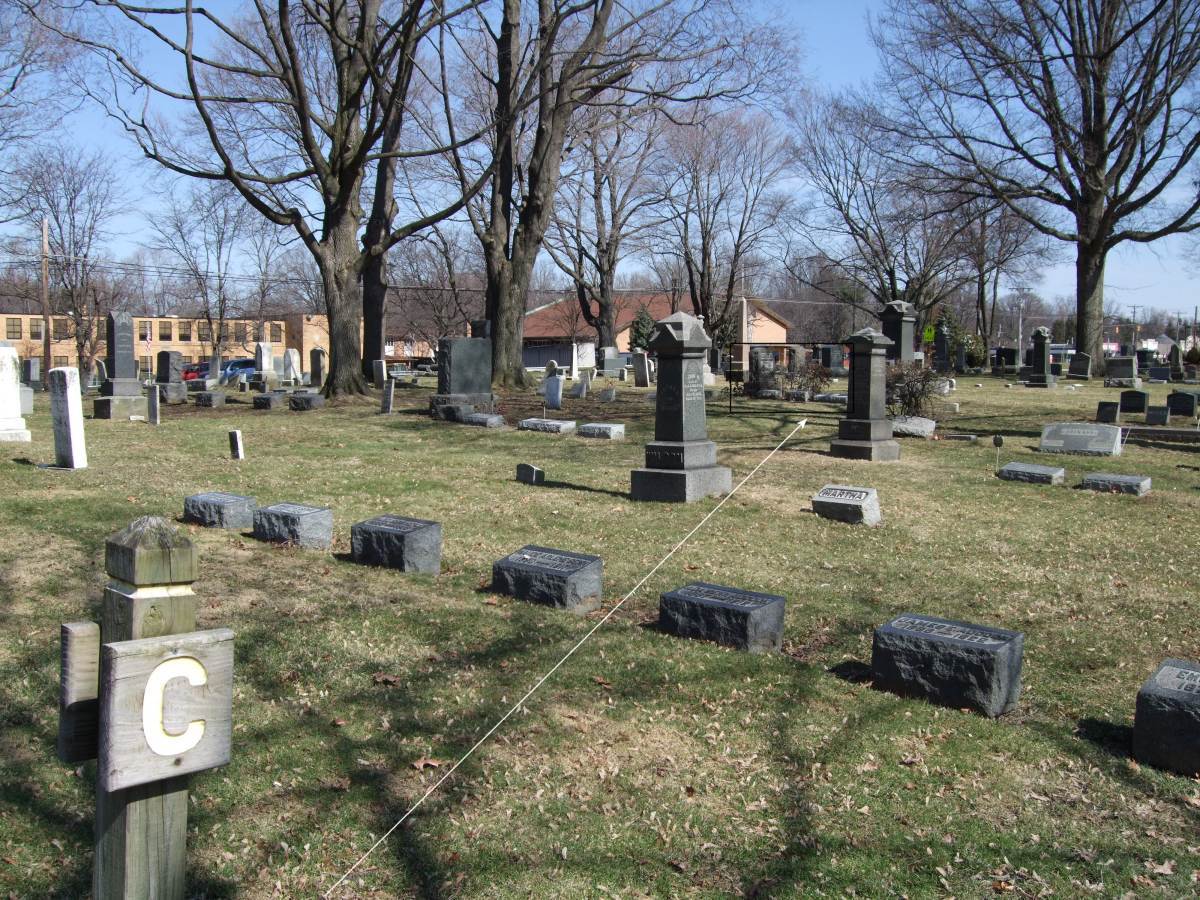
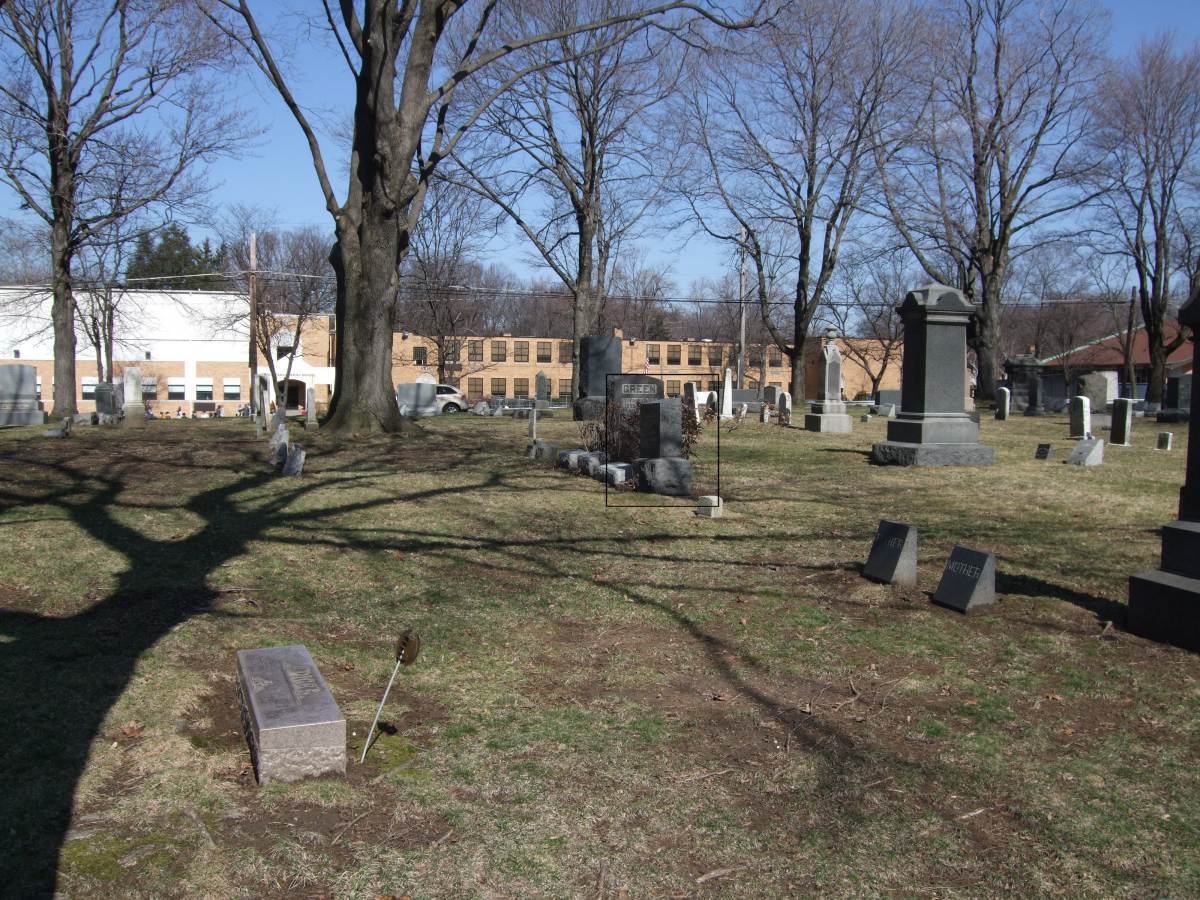

Philander Green
Monument In The Foreground
Note: Star Marker Behind "Father": GAR
1961-1965
GAR stood for "Grand
Army Of The Republic"
GREEN
Francis Marion Green
1836-1911
Ellen Stow His Wife
1837-1904
![]()
